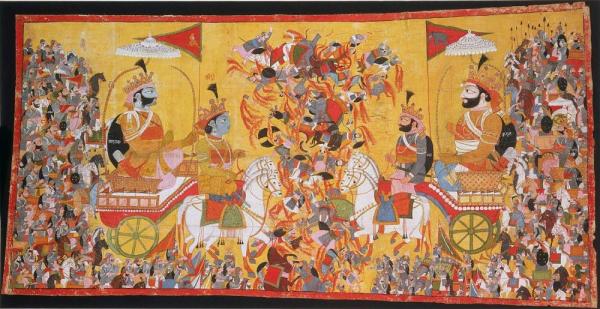The Afterlife of the Bhagavad Gita

Arjuna and his charioteer Krishna confront Karna, circa 1820
Artist/maker unknown, India, Himachal Pradesh or Jammu and Kashmir.
Used with permission from the Philadelphia Museum of Art.

Arjuna and his charioteer Krishna confront Karna, circa 1820
Artist/maker unknown, India, Himachal Pradesh or Jammu and Kashmir.
Used with permission from the Philadelphia Museum of Art.
What makes a classic work classic? Richard Davis, Chair of the Religion program at Bard College, has won a yearlong NEH fellowship to finish a study that will address this question by chronicling what he calls the “rich interpretive afterlife” of the best-known of all Hindu religious texts, the Bhagavad Gita.
An eighteen-chapter philosophical poem in classical Sanskrit composed sometime between the 5thcentury B.C.E. and the 1st century C.E., the Bhagavad Gita (“The Song of the Lord”) presents a conversation between a warrior-prince, Arjuna, and his friend and charioteer, Krishna. Arjuna, unsure whether he should take part in an impending battle against an army that includes his own cousins, seeks Krishna’s advice. According to Davis, their conversation, in which Krishna persuades Arjuna to fulfill his duty as a warrior by fighting, “offers a rich commentary on many of the key philosophical and religious issues of classical Indian culture, involving the nature of selfhood, duty, action, bondage, and liberation.”
But the heart of Davis’s book is its wide-ranging investigation of the uses to which the Bhagavad Gita has been put in later centuries and in other places. Not only has the poem been the subject of numerous philosophical commentaries in India, and been translated into that country’s many vernacular languages, it has also appeared in over three hundred English translations and been translated over three thousand times into at least fifty other languages. “Nowadays,” Davis says, “the Gita is truly a global text.” To understand how the Gita has been read in different historical settings, Davis’s book will investigate what the poem has meant to a selection of its most influential interpreters, including medieval Indian commentators, Henry David Thoreau, G.W.F. Hegel, Mohandas Ghandi,Robert Oppenheimer, B.C. Chatterji, Christopher Isherwood, and others. His book will also include observations on contemporary celebrations of the Gita, such as that at Kurukshetra, the location at which Krishna and Arjuna are supposed to have had their conversation. Ultimately, Davis is convinced, his chronicle of the Gita’s afterlife will shed light on the more general question of how “audiences in later times enable themselves to enter into dialogue with a religious work of another time and place.” His book (tentatively titled Dialogues with Krishna) is due to appear in a new series of Princeton University Press publications called “The Lives of Great Religious Books.”